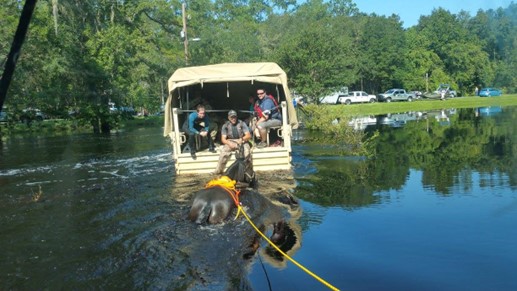Horse owners in Florida are well-accustomed to the process of cleaning up after a hurricane. Debris removal, fence and building repairs, and reestablishing the daily routine are all part of the return to normalcy. While this process may feel familiar to any horse owner in Florida, many owners are not aware that natural disasters and changing weather patterns can actually increase a horse’s risk for contracting some of the most serious infectious diseases.
The American Association of Equine Practitioners (AAEP) has designated five “core” infectious diseases and recommends that all adult horses should be vaccinated at least annually against these diseases regardless of their age, intended use, or whether or not they leave their home property. The core diseases are West Nile Virus (WNV), Eastern and Western Equine Encephalitis (EEE/WEE), rabies, and tetanus. All of these diseases are transmitted naturally through mosquitos (WNV and EEE/WEE), wildlife (rabies), or contaminated wounds (tetanus). Natural disasters and severe weather patterns often bring excessive rainfall, flooding, and displacement of both wildlife and resident animal populations, making each of these modes of disease transmission much more likely.

Horse being rescued from flooded property following Hurricane Irma. Credit: University of Florida Veterinary Emergency Treatment Services
–
The United States Environmental Protection Agency (EPA) reports that rising global average temperature is associated with widespread changes in weather patterns, and that extreme weather events such as heat waves and large storms are likely to become more frequent and intense with climate change. Average temperatures have increased across the contiguous 48 states since 1901, with an increased rate of warming over the past 30 years, while the prevalence of extreme single-day precipitation events have risen substantially since 1980. The occurrence of abnormally high annual precipitation totals has also increased in recent decades.1
=
So how does this affect your horse?
Flooding creates large areas of standing water and the perfect breeding ground for mosquitoes, the primary vector for WNV and EEE/WEE. This is further exacerbated by the warm, humid weather that typically follows hurricanes and monsoons, creating massive blooms in mosquito populations and putting your horse at substantial risk of exposure to a mosquito-borne virus. Flooding also reduces the amount of habitat space available for native wildlife populations, forcing them to relocate to higher ground. Crowding of wildlife and domestic animal populations on limited dry ground increases their contact – and the risk of contact with raccoons, foxes, and skunks; all species known to carry the Rabies virus.
High winds can damage structures and property and leave large amounts of dangerous debris on or around your horse’s environment. Broken fences, downed wires, and sharp objects such as nails and metal roofing can cause lacerations or puncture wounds and increase your horse’s risk of contracting tetanus, which is caused by the bacterial, Clostridium tetani.
As if all that wasn’t enough, if a natural disaster forces you to evacuate your horse to a shelter location, they will have a greater risk of contracting infectious diseases that tend to spread when horses are housed in close quarters. These diseases include the respiratory viruses Equine Influenza and Equine Herpesvirus, as well as the bacteria Streptococcus equi, which causes Strangles. All are highly contagious pathogens and are known to cause outbreaks of illness during times of stress, travel, and crowding….all of which could be an unavoidable reality in a natural disaster evacuation scenario.
=
The Good News
Thankfully, most if not all of the aforementioned diseases are highly preventable through vaccination. Warm wet climates, like those of the Southeastern United States, may require more frequent boosters for mosquito-borne viruses, and this may also apply to regions of the country experiencing unusually warm weather in the winter and early spring. Remember, the eve of a natural disaster is definitely not the time to be scheduling a vaccine appointment, so work with your veterinarian to create a comprehensive preventative healthcare program that keeps your horses protected year-round – on sunny days and stormy days alike.
=
Further information about equine infectious diseases and how to prevent them can be found by using the following links:
American Association of Equine Practitioner’s Infectious Disease Guidelines
Equine Disease Communication Center’s Disease Information
=
Reference:
- United States Environmental Protection Agency: Climate Change Indicators: Weather and Climate. August 2022
- Livestock Owners are Encouraged to be on the Lookout for New World Screwworm in the Wake of Outbreaks in Central America - March 21, 2025
- Horse Feed and Cattle Feed Don’t Mix: 70 Horses Die After Ingesting Feed Contaminated with Monensin - September 6, 2024
- Don’t Let Your Horse Get Stricken by Strangles - March 8, 2024
